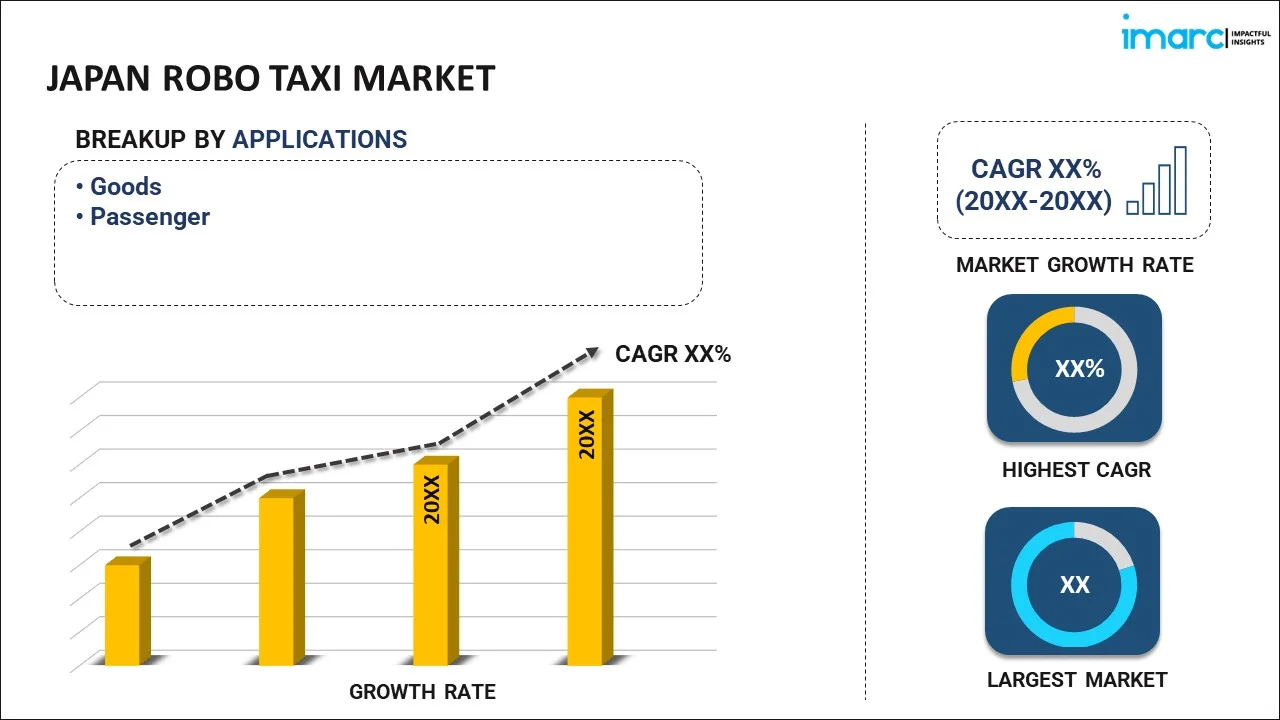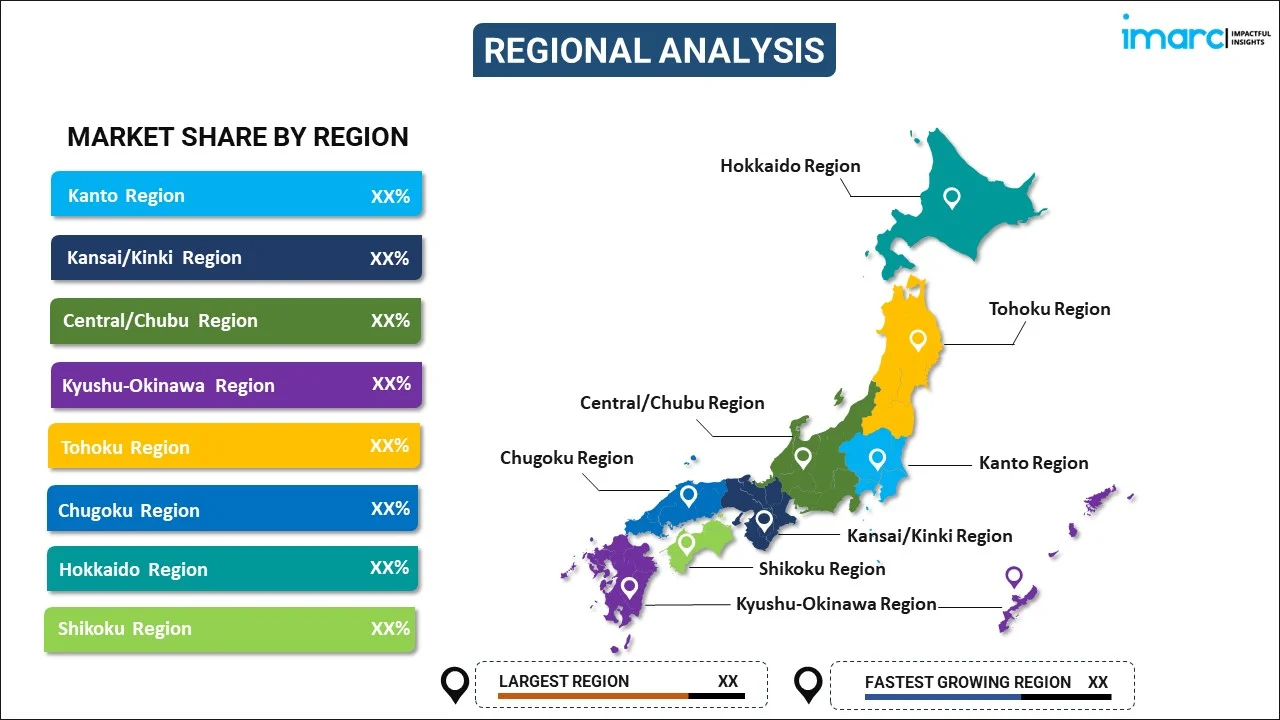
Japan Robo Taxi Market Report by Application (Goods, Passenger), Level of Autonomy (Level 4, Level 5), Vehicle (Car, Shuttle/Van), Service (Rental, Station-based), Propulsion (Electric, Hybrid, Fuel Cell), and Region 2025-2033
Market Overview:
Japan robo taxi market size reached USD 83.2 Million in 2024. Looking forward, IMARC Group expects the market to reach USD 11,019.2 Million by 2033, exhibiting a growth rate (CAGR) of 65.3% during 2025-2033. The market is being driven by significant factors, such as increasing traffic congestion issues and the presence of regulations and legal structures that offer a solid basis for the development of robo-taxi services.
|
Report Attribute
|
Key Statistics
|
|---|---|
|
Base Year
|
2024
|
|
Forecast Years
|
2025-2033
|
|
Historical Years
|
2019-2024
|
| Market Size in 2024 | USD 83.2 Million |
| Market Forecast in 2033 | USD 11,019.2 Million |
| Market Growth Rate (2025-2033) | 65.3% |
A robo taxi, alternatively termed as an autonomous taxi or self-driving taxi, represents an innovative transportation solution employing self-driving vehicles for passenger transport, eliminating the requirement for a human operator. These vehicles come equipped with state-of-the-art sensors, cameras, lidar, radar systems, and artificial intelligence algorithms. These technologies empower them to autonomously navigate within urban settings, recognize obstacles, and make instant decisions to ensure the safety and efficiency of the journey.
Japan Robo Taxi Market Trends:
With a growing emphasis on sustainability and the reduction of carbon emissions, robo taxis offer an environmentally friendly alternative to traditional gasoline-powered vehicles, which is primarily driving the regional market. Electric and autonomous robo taxis have the potential to significantly decrease greenhouse gas emissions, contributing to a cleaner and more eco-conscious transportation landscape. Additionally, in the face of increasing urbanization and traffic congestion challenges experienced by cities worldwide, robo taxis emerge as a promising solution, thereby bolstering the market growth in Japan. Apart from this, on-demand services eliminate the need for personal vehicle ownership expenses, such as maintenance, insurance, and parking fees. Moreover, the potential reduction in accidents resulting from human error through autonomous vehicles enhances transportation safety for passengers and pedestrians alike. This heightened safety aspect encourages consumers to embrace robo taxis as a reliable mode of transportation. Governments and regulatory bodies across the globe are actively engaged in formulating guidelines and policies to facilitate the safe integration of autonomous vehicles into public transportation systems. Supportive regulations and legal frameworks establish the necessary groundwork for the growth of the robo taxi market. Furthermore, rapid advancements in autonomous vehicle technology, including artificial intelligence, sensor technology, and computing power, have paved the way for the development and deployment of robo taxis. These innovations enhance the safety, reliability, and efficiency of autonomous vehicles, instilling confidence in potential users and stakeholders, which in turn, is expected to fuel the regional market in the coming years.
Japan Robo Taxi Market Segmentation:
IMARC Group provides an analysis of the key trends in each segment of the market, along with forecasts at the country level for 2025-2033. Our report has categorized the market based on application, level of autonomy, vehicle, service, and propulsion.
Application Insights:

- Goods
- Passenger
The report has provided a detailed breakup and analysis of the market based on the application. This includes goods and passenger.
Level of Autonomy Insights:
- Level 4
- Level 5
A detailed breakup and analysis of the market based on the level of autonomy have also been provided in the report. This includes level 4 and level 5.
Vehicle Insights:
- Car
- Shuttle/Van
The report has provided a detailed breakup and analysis of the market based on the vehicle. This includes car and shuttle/van.
Service Insights:
- Rental
- Station-based
A detailed breakup and analysis of the market based on the service have also been provided in the report. This includes rental and station-based.
Propulsion Insights:
- Electric
- Hybrid
- Fuel Cell
The report has provided a detailed breakup and analysis of the market based on the propulsion. This includes electric, hybrid, and fuel cell.
Regional Insights:

- Kanto Region
- Kansai/Kinki Region
- Central/ Chubu Region
- Kyushu-Okinawa Region
- Tohoku Region
- Chugoku Region
- Hokkaido Region
- Shikoku Region
The report has also provided a comprehensive analysis of all the major regional markets, which include Kanto Region, Kansai/Kinki Region, Central/ Chubu Region, Kyushu-Okinawa Region, Tohoku Region, Chugoku Region, Hokkaido Region, and Shikoku Region.
Competitive Landscape:
The market research report has also provided a comprehensive analysis of the competitive landscape. Competitive analysis such as market structure, key player positioning, top winning strategies, competitive dashboard, and company evaluation quadrant has been covered in the report. Also, detailed profiles of all major companies have been provided.
Japan Robo Taxi Market Report Coverage:
| Report Features | Details |
|---|---|
| Base Year of the Analysis | 2024 |
| Historical Period | 2019-2024 |
| Forecast Period | 2025-2033 |
| Units | Million USD |
| Scope of the Report | Exploration of Historical and Forecast Trends, Industry Catalysts and Challenges, Segment-Wise Historical and Predictive Market Assessment:
|
| Applications Covered | Goods, Passenger |
| Level of Autonomies Covered | Level 4, Level 5 |
| Vehicles Covered | Car, Shuttle/Van |
| Services Covered | Rental, Station-based |
| Propulsions Covered | Electric, Hybrid, Fuel Cell |
| Regions Covered | Kanto Region, Kansai/Kinki Region, Central/ Chubu Region, Kyushu-Okinawa Region, Tohoku Region, Chugoku Region, Hokkaido Region, Shikoku Region |
| Customization Scope | 10% Free Customization |
| Post-Sale Analyst Support | 10-12 Weeks |
| Delivery Format | PDF and Excel through Email (We can also provide the editable version of the report in PPT/Word format on special request) |
Key Questions Answered in This Report:
- How has the Japan robo taxi market performed so far and how will it perform in the coming years?
- What has been the impact of COVID-19 on the Japan robo taxi market?
- What is the breakup of the Japan robo taxi market on the basis of application?
- What is the breakup of the Japan robo taxi market on the basis of level of autonomy?
- What is the breakup of the Japan robo taxi market on the basis of vehicle?
- What is the breakup of the Japan robo taxi market on the basis of service?
- What is the breakup of the Japan robo taxi market on the basis of propulsion?
- What are the various stages in the value chain of the Japan robo taxi market?
- What are the key driving factors and challenges in the Japan robo taxi?
- What is the structure of the Japan robo taxi market and who are the key players?
- What is the degree of competition in the Japan robo taxi market?
Key Benefits for Stakeholders:
- IMARC’s industry report offers a comprehensive quantitative analysis of various market segments, historical and current market trends, market forecasts, and dynamics of the Japan robo taxi market from 2019-2033.
- The research report provides the latest information on the market drivers, challenges, and opportunities in the Japan robo taxi market.
- Porter's five forces analysis assist stakeholders in assessing the impact of new entrants, competitive rivalry, supplier power, buyer power, and the threat of substitution. It helps stakeholders to analyze the level of competition within the Japan robo taxi industry and its attractiveness.
- Competitive landscape allows stakeholders to understand their competitive environment and provides an insight into the current positions of key players in the market.
Need more help?
- Speak to our experienced analysts for insights on the current market scenarios.
- Include additional segments and countries to customize the report as per your requirement.
- Gain an unparalleled competitive advantage in your domain by understanding how to utilize the report and positively impacting your operations and revenue.
- For further assistance, please connect with our analysts.
 Inquire Before Buying
Inquire Before Buying
 Speak to an Analyst
Speak to an Analyst
 Request Brochure
Request Brochure
 Request Customization
Request Customization




.webp)




.webp)












